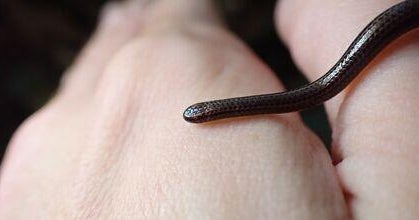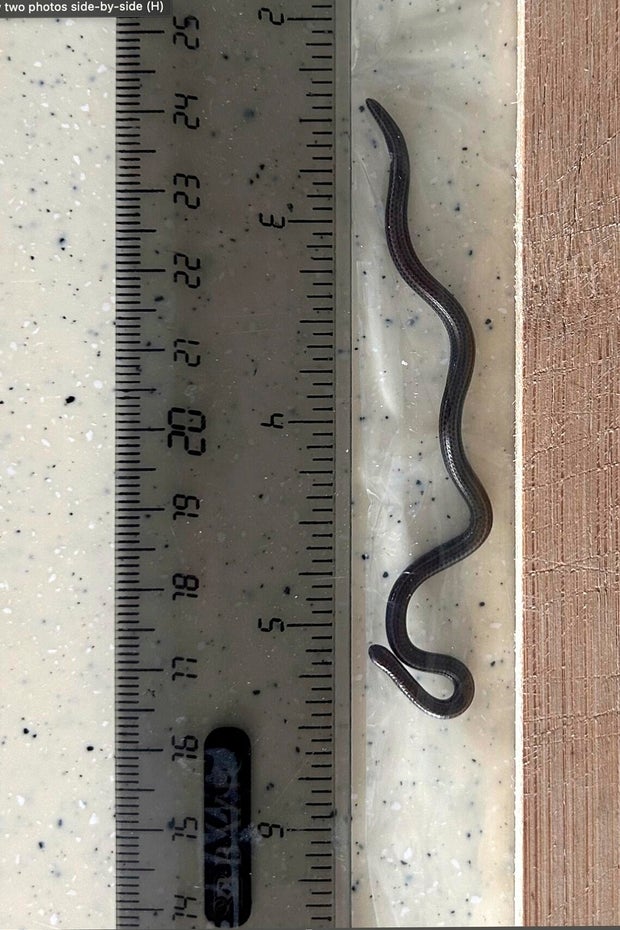World’s smallest-known snake found under rocks in Barbados after nearly 20 years
For nearly two decades, no one had spotted the world’s smallest-known snake.
Some scientists worried that maybe the Barbados threadsnake had become extinct, but one sunny morning, Connor Blades lifted a rock in a tiny forest in the eastern Caribbean island and held his breath.
Connor Blades/Re:wild via AP
“After a year of searching, you begin to get a little pessimistic,” said Blades, project officer with the Ministry of Environment in Barbados.
The snake can fit comfortably on a coin, so it was able to elude scientists for almost 20 years.
Scientifically named Tetracheilostoma carlae, the petite creature is listed as Critically Endangered in the International Union for Conservation of Nature’s Red List of Threatened Species when it was last assessed in 2015.
Too tiny to identify with the naked eye, Blades placed it in a small glass jar and added soil, substrate and leaf litter.
Photo by Connor Blades/Re:wild
Several hours later, in front of a microscope at the University of the West Indies, Blades looked at the specimen. It wriggled in the petri dish, making it nearly impossible to identify.
“It was a struggle,” Blades recalled, adding that he shot a video of the snake and finally identified it thanks to a still image.
It had pale yellow dorsal lines running through its body, and its eyes were located on the side of its head.
“I tried to keep a level head,” Blades recalled, knowing that the Barbados threadsnake looks very much like a Brahminy blind snake, best known as the flower pot snake, which is a bit longer and has no dorsal lines.
On Wednesday, the Re:wild conservation group, which is collaborating with the local environment ministry, announced the rediscovery of the Barbados threadsnake.
“Rediscovering one of our endemics on many levels is significant,” said Justin Springer, Caribbean program officer for Re:wild who helped rediscover the snake along with Blades. “It reminds us that we still have something important left that plays an important role in our ecosystem.”
The Barbados threadsnake has only been seen a handful of times since 1889. It was on a list of 4,800 plant, animal and fungi species that Re:wild described as “lost to science.”
There’s no information on its population and the most recent record of the snake was a 2005 photograph from near Hillaby town in St. Thomas Parish, according to the IUCN. One of the oldest known records of the species dates back to 1918, and it has only been rarely spotted since then, with a few documentations from 1966, 1997 and 2008, the Switzerland-based conservation organization said.
“Given the dense human population on Barbados, if the species was simply underrecorded it seems likely that local people would be aware of additional records,” the IUCN said on its website. “The lack of records suggests that this species is genuinely rare and restricted.”
The snake is blind, burrows in the ground, eats termites and ants and lays one single, slender egg. Fully grown, it measures up to four inches.
“They’re very cryptic,” Blades said. “You can do a survey for a number of hours, and even if they are there, you may actually not see them.”
But on March 20 at around 10:30 a.m., Blades and Springer surrounded a jack-in-the-box tree in central Barbados and started looking under rocks while the rest of the team began measuring the tree, whose distribution is very limited in Barbados.
“That’s why the story is so exciting,” Springer said. “It all happened around the same time.”
S. Blair Hedges, a professor at Temple University and director of its center for biology, was the first to identify the Barbados threadsnake. Previously, it was mistakenly lumped in with another species.
In 2008, Hedges’ discovery was published in a scientific journal, with the snake baptized Tetracheilostoma carlae, in honor of his wife.
“I spent days searching for them,” Hedges recalled. “Based on my observations and the hundreds of rocks, objects that I turned over looking for this thing without success, I do think it is a rare species.”
That was June 2006, and there were only three other such specimens known at the time: two at a London museum and a third at a museum collection in California that was wrongly identified as being from Antigua instead of Barbados, Hedges said.
Hedges said that he didn’t realize he had collected a new species until he did a genetic analysis.
“The aha moment was in the laboratory,” he said, noting that the discovery established the Barbados threadsnake as the world’s smallest-known snake.
Hedges then became inundated for years with letters, photographs and emails from people thinking they had found more Barbados threadsnakes. Some of the pictures were of earthworms, he recalled.
“It was literally years of distraction,” he said.
Scientists hope the rediscovery means that the Barbados threadsnake could become a champion for the protection of wildlife habitat.
A lot of endemic species on the tiny island have gone extinct, including the Barbados racer, the Barbados skink and a particular species of cave shrimp.
“I hope they can get some interest in protecting it,” Hedges said. “Barbados is kind of unique in the Caribbean for a bad reason: it has the least amount of original forest, outside of Haiti.”







